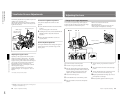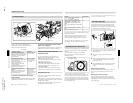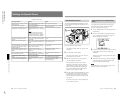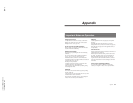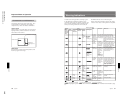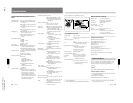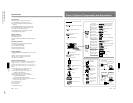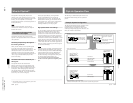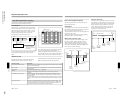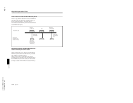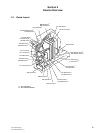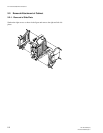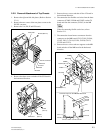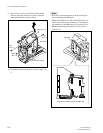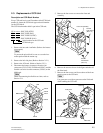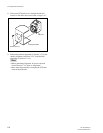
1-53
DXC-D35/D35WS(UC)
DXC-D35P/D35WSP(CE) V1
104
Appendix
Appendix
Data Generated When Shooting
The following describes the kinds of data that is
generated when using the ClipLink function.
Index Pictures
When shooting, a single-frame image from the Mark
IN point at the start of each scene is recorded as a still
picture into the DSR-1/1P’s internal memory. These
images are called “Index Pictures”. When you finish
shooting, the Index Pictures from all scenes are
recorded onto the tape after the last scene.
Up to 32 Index Pictures can be recorded onto the tape
space normally occupied by one frame, as shown
below.
Seven frame spaces are reserved at the end of the last
scene as a recording area for Index Pictures. (A
cassette with 16 Kbits of cassette memory can record
up to 198 Index Pictures, and a cassette with 4 Kbits of
cassette memory can record up to 45 Index Pictures.)
ClipLink log data
ClipLink log data can be recorded automatically or
manually into the cassette memory for use as a
convenient alternative to the conventional “shot list”.
ClipLink log data includes the following items.
1
5
9
13
17
21
25
29
2
6
10
14
18
22
26
30
3
7
11
15
19
23
27
31
4
8
12
16
20
24
28
32
0 90 180 270 360 450 540 630
60
120
180
240
300
360
420
(72)
(144)
(216)
(288)
(360)
(432)
(504)
Tape
Scene 1
Scene 2
Scene 3
Scene n
DSR-1/1P’s internal
memory
After shooting, the Index
Pictures in the internal
memory are recorded onto
the video tape.
Index Picture
480 lines (NTSC) or 576 lines (PAL)
720 dots
ClipLink log data
Description
Reel number (cassette number)
Data (maximum length: 8 digits) consisting of alphanumeric characters and/or symbols
(This is left blank at shipping.)
Scene number
A three-digit number from 001 to 198 (starts at 001 and is automatically incremented
with each scene).
Take number
This cannot be changed (set to “1” at shipping).
OK/NG
Indicates the OK/NG status of a particular scene. (In the OK case, nothing is
recorded.)
Mark IN/OUT point time codes
These are the time codes that indicate the Mark IN and Mark OUT points for each
scene (HH:MM:SS). These time codes are recorded when the camcorder has been
set to Mark mode.
The frame digit is incremented at each Mark IN point and is decremented at each Mark
OUT point. (For details, see “Time codes recorded for Mark IN/OUT points” on page
106)
Cue point time code This is the time code that indicates the cue points (valid up to the frame digit). This
time code is recorded when the camcorder has been set to Cue mode. When in this
mode, the time codes at the start and end of a recording (the Rec IN and Rec OUT
time codes) are automatically recorded as Mark IN/OUT points.
ClipLink Operation Flow
Appendix
105
Appendix
How to record ClipLink log data
The following describes how to record the various
ClipLink log data items.
OK/NG status
To designate a scene as “NG”, press the NG button on
the camcorder while shooting the scene or at any time
before you begin shooting the next scene.
All scenes that do not receive an “NG” designation are
recorded as “OK” scenes.
(When you exit the VCR recording mode, changing
the OK/NG status is no longer possible.)
Mark IN/OUT points time codes
This data is especially useful when shooting a video
program for which a scenario has been created.
Set the camcorder to Mark mode before you start
shooting. While shooting, each time you press the
camcorder’s TAKE button, Mark IN and Mark OUT
time codes are recorded alternately.
Cue point time codes
This type of data is especially useful when shooting
scenes that may contain unexpected events, such as
when shooting for sports coverage or documentaries.
Set the camcorder to Cue mode before you start to
record. While recording, each time you press the
camera’s TAKE button, the current time code is
recorded as a cue point time code.
Start
recording
Index Picture 1
Index Picture 2
End
recording
Scene 1
Take 1
Scene 2
Take 1
Mark IN
(manual
recording)
Mark OUT
(manual
recording)
Mark IN (manual
recording)
Mark OUT (manual
recording)
Start
recording
Index Picture 1
End
recording
Scene 1
Take 1
Rec IN
(automatic
recording)
Rec OUT
(automatic
recording)
Cue point
time code
(manual
recording)
Cue point
time code
(manual
recording)
Cue point
time code
(manual
recording)



